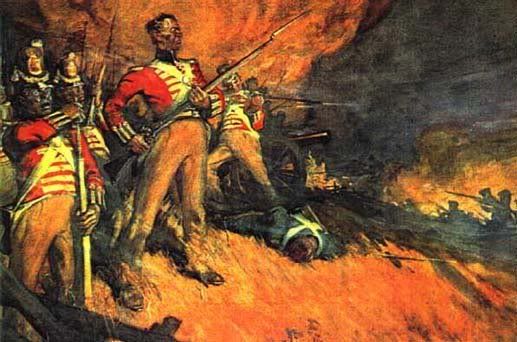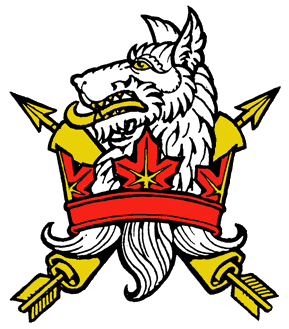Some Basics

“A wargame should involve the figures and little more. The position and identity of the wargame figures I have painted should convey most of the information I need to know. In reality a commander would have little knowledge of the exact state all his units were in, and so it spoils the atmosphere of a game if we the players know too much.”
“While wargaming players should think as little as possible like wargamers and as much as possible like battle commanders. Otherwise, they become accountants. Wargames, like battles, should be unpredictable.”
“It should always be possible for things to go wrong or right. The die rolls in the game should always make it possible for the weak unit to triumph over the strong. The feeling of risk, of danger, should always be present to keep things interesting, and every game should include some surprises.”
• Nikolas Lloyd
Thoughts on Wargame Rules Design
Following through the vast, interconnected rabbit warren of websites, I found some very thoughtful and sharp essays and musings by Nikolas Lloyd. A few of his maxim-like entries start off this entry.
Lloyd’s Thoughts on Wargame Rules Design has the brevity and clarity a writer enjoys when re-reading Strunk and White, or George Orwell on Propaganda and English; it is an invigorating exercise, and has helped me focus on a few things I am trying to accomplish with this blog and my War of 1812 rules project.
Remember too that this is not yet anywhere meant to be a finished system. What we have here is the messy ‘thinking out loud’ of the process involved in getting to something like that. Keep that in mind while writing posts and critiques.
GOAL
These rules will primarily be for the war along the Canadas and US border States. Sail and Southern US operations are beyond my interest and desire at this point...sorry...no offence is meant, that’s just the where my attention and research abilities fall.
I hope to emerge with two related rules systems. One will be for 15mm company/battalion/brigade engagments. The other will be for skirmish/sentry/patrol/vedette operations, which I have become excited about doing for the 40mm scale, lured by the animation and detail of Chris Hughes’s figures Sash and Sabre figures.
Both would mesh, either in campaign, or pre or post engagement operations...or happily spin in an unrelated realm of their own, depending on requirement and choice.
I’ll put aside the skirmish half of the project for a while. And, in the interregnum, hope Chris does get around to some American and Canadian figures to make his line the place to get War of 1812 skirmish figures.
Of course, as the main point is fashioning wargame rules here, it goes without saying that I am standing on the shoulders of others here. From the memories of H.G. Wells, Donald Featherstone, Charles Grant, G. W Jeffrey, and David Nash borrowed as a kid from the North York Public Library, to a very nice pair of War of 1812 rules by the minds at The Perfect Captain, another called With MacDuff To The Frontier, and almost a dozen others I’ve been going through (and I haven’t even got hold of older ones such as Rocket's Red Glare from fellow Canadians out west.)...all have influence and some persuasion. And of course, any mention of looking at intiative-based wargames owes all to Crossfire and Arty Conliffe; other systems like Piquet and Les Grognards are on the list to look at too. As I said - on the shoulders of others.
KEY ELEMENTS
The bones of the War of 1812 rules I hope to work out, mull over, pull apart, and fret over in these pages are fairly simple.
1) I want to set a more realistic look and scale and operation to the units on the table.
2) I desire to flee the turn-based wargame structure, and try to set this on a workable, engaging, challenging, fun...and swift-moving... initiative-based system.
3) Flexibility of units, scenarios, force compositions, geography and commanders has to be high to prevent boredom and rote playing.
4) Surprise, frustration and luck should always keep things on edge...but in a realistic manner.
5) The Canadian weather should be a factor, especially when operations and engagements creep into our unpredictable and fluid shoulder seasons of spring and fall.
STARTING POINTS
A) Line Infantry
Two biggies right off.
• I have set a scale of 1” = 4 yards.
• Each figure on the table represents two in life.
I am beginning with line infantry organization, and presently am working with 1 inch X 2 inch bases of 12 figures (1 officer and 11 men), in two ranks, representing a platoon. The platoon was the functional tactical unit in companies, and was usually 50 men. Most of the British and American companies through the war were about 50 men, or two platoons. So each 50 man company on the table would be represented by two 12 man platoons. Stronger companies of 75, as found in some of the elite US regiments, would have three platoons, or 36 figures.
A 1” square base additionally to the platoons and companies would be for command figures apart from the integrated company officers - ensigns/colours, colour party...whatever fits. I think I would mount a colonel separately on horse, on a round base. For larger regiments/battalions I might even think of adding another mounted officer for Liet. Col. or a major.
A six company regiment (not uncommon, due to illness, lack of re-inforcements, and detatched companies) takes up 24” in line on the proposed scale...or about 100 yards. There’s some animated discussion about whether the British would maintain their 22 inches per man in line, or loosen up for field conditions. I can see the merit in both arguments. But having spent hundreds of hours on a hot square drilling, I would question whether a unit would drill and train intensively one way, only to disregard it and adopt another format...one that would make all the reference points and cues of the drilling, well, rather pointless...and at the important moment, when all that training was meant to be automatic.
A 24” regiment or battalion is both an impressive and yet a weak, emaciated thing to behold. One joy of gaming the War of 1812 is that it is one of the few Napoleonic wars that can allow a really good table-top representation of a unit’s true look on the table.
[A footnote: the 1” deep stand represents about 4 yards...which is far more than two ranks would normally occupy (about 3.5 feet first and second rank). But it is an accurate accounting, if one factors in the subalterns, sergeants and other file closers behind the two ranks. On a 1” base, there is no room to actually glue them on in a realistic manner...but safely assume, they exist...even if in some spirit realm.]
So, basing for units on both sides that would be in close order (Regulars, Fencibles, Incorporated and Embodied Militia, veteran militias, 2nd & 3rd Regiments of Artillery).
Flank companies, certain Fencible regiments, and rifle regiments could be based in regular platoons, and in skirmish order of 3 pairs of figures (6 figures) per 2 inch X 1 inch platoon base. A company in skirmish order would have 4 such bases, and on one I would have an officer and bugler. Building troops so that such units based both ways would be most useful, depending on roles and formations.
The same could go for some militia units or companies with the ability for line and skirmish roles.
Irregulars and natives I would mount 5 to a 1 inch by 2 inch base, in a less structured layout.
•••







0 Comments:
Post a Comment
<< Home